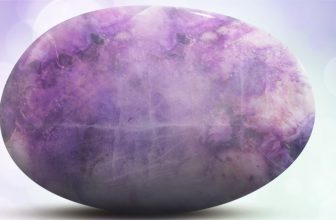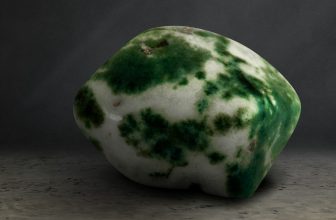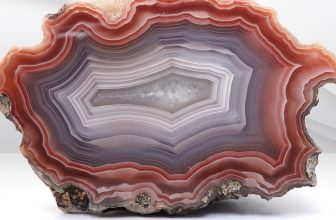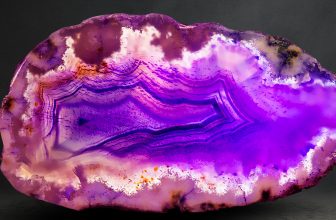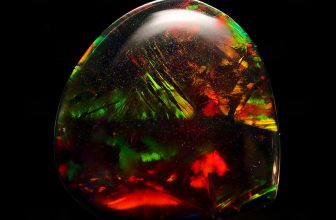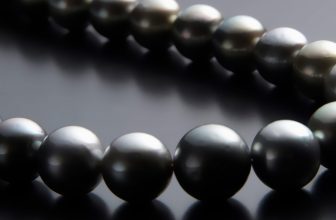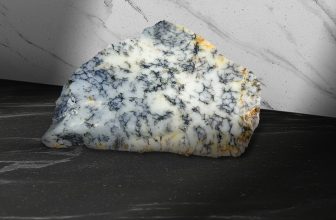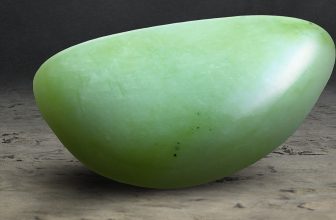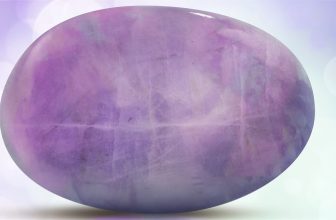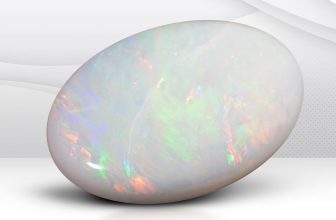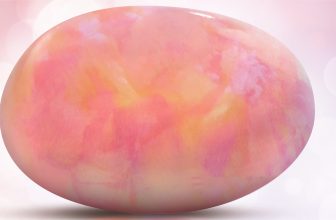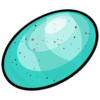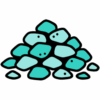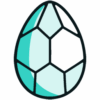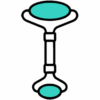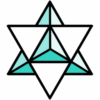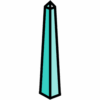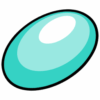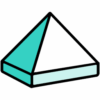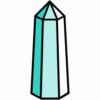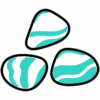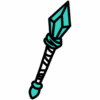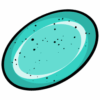Gua Sha Stones
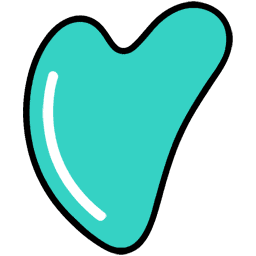 Ancient Touch, Modern Glow
Ancient Touch, Modern Glow
Ever feel that your skin looks tired no matter how much rest you get? Or that tension seems to build in your face and neck after long hours at a screen? Enter the gua sha stone – a small, curved tool that’s been quietly reshaping self-care routines across the world.
At first glance, it looks simple: a polished piece of jade, rose quartz, or bian stone. Yet in skilled hands, it becomes something transformative – a bridge between ancient healing and modern wellness. Gua sha stones trace their roots to traditional Chinese medicine, where “gua” means to scrape and “sha” refers to the light red marks that appear as circulation increases beneath the skin.
Originally, practitioners used coins, spoons, or horns to stimulate blood flow and release “stagnant energy.” Today, we see beautifully carved crystal tools designed not for bruising, but for rejuvenation. They fit perfectly within the world of crystals and gemstones – merging tactile beauty with intentional healing. Whether you’re seeking smoother skin, muscle relief, or a mindful ritual to unwind at night, the gua sha stone offers an elegant, time-honored way to reconnect body and mind.
The Origins of Gua Sha
How does a centuries-old healing technique become a trend on bathroom counters worldwide? The story of gua sha stretches back thousands of years through Chinese history, rooted in the belief that illness and tension often arise from stagnation – when blood or energy (qi) stops flowing freely. The solution was both simple and profound: scrape the skin with a smooth-edged tool to release that stagnation and restore balance.
The very name says it all – gua (to scrape) and sha (the reddish marks or “petechiae” that surface after treatment). Practitioners saw these marks not as damage, but as signs of renewal. As circulation improved, the body could heal itself more efficiently.
This practice wasn’t confined to China alone. Versions of gua sha spread across East and Southeast Asia – known as cạo gió in Vietnam and kerokan in Indonesia – where families used it as a home remedy for fever, muscle pain, and fatigue. Ancient tools ranged from water-buffalo horns to ceramic spoons and polished stones – anything that could glide firmly over the skin.
Over time, gua sha’s purpose evolved. As beauty rituals grew in popularity, traditional scraping transformed into a gentler, facial-focused version. Out went the deep tissue marks; in came delicate, rhythmic strokes along the contours of the face and neck.
Now, these same principles have been reimagined with gemstone tools – carved from jade, rose quartz, or bian stone. Each material brings not only a physical sensation – coolness, smoothness, gentle weight – but also a metaphysical presence. Jade is said to balance and protect, rose quartz to open the heart and encourage self-love.
The Forms and Materials of Gua Sha Stones
Have you ever wondered why gua sha stones come in so many shapes – some shaped like hearts, others like wings or teardrops? It’s not just about aesthetics. The shape and material of your gua sha stone change the entire experience.
Traditional gua sha tools were once made from simple materials like bone, horn, or even metal. But today’s designs have evolved into exquisite objects of ritual – often carved from gemstones that feel as good to hold as they are to behold.
Jade, the classic choice, remains the most iconic. Cool to the touch and naturally dense, it glides effortlessly across the skin and is associated with balance, peace, and protection in many cultures. Rose quartz, on the other hand, feels slightly softer. Its blush-pink hue and gentle energy are said to invite self-love and compassion – perfect for evening facial rituals. Then there’s bian stone, a lesser-known but ancient material, believed to contain trace minerals that subtly interact with the skin’s surface.
Each stone type brings its own tactile personality. Jade feels grounding and sturdy, rose quartz is silky and nurturing, and bian stone carries a faint natural warmth once held in the hand.
The form of the tool matters just as much. Heart-shaped stones hug the jawline and cheekbones, while flat, rounded boards are ideal for broader areas like the back or shoulders. Some tools feature comb-like edges for scalp massage, or pointed tips designed to reach delicate spots near the nose and eyes.
The Ritual of Flow
So you’ve got your stone – now what? Gua sha may look intuitive, but a few mindful techniques can transform it from a simple massage into a self-care ceremony.
Start by creating an atmosphere of calm. Dim the lights, take a few slow breaths, and let your mind settle. Cleanse your skin, then apply a thin layer of facial oil or serum. This step is vital – it allows the stone to glide smoothly, preventing unnecessary tugging.
Hold the gua sha tool at about a 15–30° angle against your skin – almost flat, but not quite. Begin at the neck, moving upward and outward in long, gentle strokes. Use a light touch for the face – you’re guiding energy and lymphatic flow, not scraping deeply. For the body, such as shoulders or legs, you can apply firmer pressure, following the natural direction of muscle fibers.
Consistency is key. Even a few minutes daily can help release tension and support circulation. Think of it less as a beauty hack and more as a moving meditation – each stroke an act of grounding, each breath a reset.
Clean your stone after every use with warm water and mild soap, then dry it thoroughly. Because many crystals are porous, they can harbor bacteria if not cared for properly. Store your stone in a soft cloth or pouch to prevent scratches – and if you love the cooling sensation, keep it in the refrigerator between uses.
For those blending gua sha with crystal practice, this is the moment to weave in intention. Some users like to set a small affirmation before they begin – “I release tension,” “I invite balance,” “I glow from within.” It might sound small, but as your stone glides along the contours of your face, those words echo softly through your energy field.
Between Science and Sensation
Can a few graceful strokes of stone really change your skin or ease deep-seated tension? The answer, as with most holistic practices, lies somewhere between tradition and science.
Fans of gua sha often describe it as life-changing – claiming it reduces puffiness, sculpts the face, melts away jaw tension, and even improves mood. And while some of those results are subjective, there’s genuine physiology at play.
The scraping motion of gua sha stimulates microcirculation – increasing blood flow to the area being massaged. Some small studies have shown this can help relieve muscle pain and even improve range of motion in people with chronic stiffness or neck issues. Others note that the technique supports lymphatic drainage, helping to reduce temporary swelling or puffiness, especially around the eyes and jaw.
But let’s be honest: gua sha isn’t a miracle cure. The marks left on the skin during traditional treatments – the famous sha – are a reminder that this is a physical technique, not magic. Research is still limited, and most scientific studies are small. So while gua sha can enhance relaxation, support circulation, and promote a healthy glow, it shouldn’t replace medical treatment for serious conditions.
That said, the modern gua sha experience goes beyond skin-deep results. There’s an undeniable mind-body connection that happens when you take a few quiet moments to care for yourself. The slow, repetitive motions calm the nervous system, turning stress into stillness.
And when you use a gemstone gua sha tool – say, a jade stone that stays cool to the touch or a rose quartz piece that radiates a soft warmth – the experience takes on an added sensory and energetic dimension. Whether or not you believe in crystal energy, there’s something soothing about feeling a natural, ancient mineral against your skin. It’s tactile therapy, mindfulness, and self-love rolled into one graceful ritual.
So while the scientific verdict is still forming, the emotional and sensory benefits of gua sha are clear. It offers not only a glow on the outside but a pause on the inside – a brief moment of balance in a world that rarely slows down.
Staying Safe in the Flow
As gentle as gua sha may feel, it’s still a form of bodywork – and like any therapeutic practice, it deserves respect. Knowing how to use your stone safely ensures you reap the benefits without any unwelcome surprises.
Traditional body gua sha often leaves behind faint red or purple marks, known as petechiae. These marks fade within a few days and are considered a sign of improved circulation – but they’re not something you should aim for in facial gua sha. On delicate skin, use only light pressure. If you notice persistent redness, tenderness, or broken capillaries, ease up or give your skin a few days to recover.
Avoid using a gua sha stone on broken, inflamed, or sunburned skin, and skip it altogether if you’re on blood-thinning medication or have a bleeding disorder. Pregnant users should avoid vigorous body gua sha, especially on the abdomen and lower back, unless advised otherwise by a healthcare professional.
Cleanliness matters too. Because gemstone tools can be slightly porous, they may harbor bacteria if not washed properly. After each use, clean your stone with warm water and mild soap, then dry it completely before storing.
Inspect your tool regularly for chips or sharp edges – even a tiny crack can scratch the skin. If your gua sha stone is made of softer material (like rose quartz), handle it gently, and consider keeping it in a padded case or pouch.
Above all, listen to your body. Gua sha should never hurt. If it does, stop. The goal is relaxation and renewal, not intensity.
Choosing Your Stone
If you’ve ever held a gua sha stone and felt instantly drawn to it, that’s no coincidence. Choosing the right stone isn’t just about what works – it’s about what feels right. This is where practicality meets intuition, where mineral energy meets mindful ritual.
When you’re shopping for a gua sha stone, start by looking closely at quality. Authentic gemstones have natural variations – tiny patterns, shifts of color, or mineral flecks that reveal their origin. Be wary of tools that look too uniform or glossy; they may be dyed glass or synthetic stone. A real crystal feels cool, substantial, and grounded in your hand.
The shape matters too. A heart-shaped gua sha tool gently follows the contours of the face and jawline. Wing-shaped stones work well along the cheekbones and neck, while rectangular boards are great for larger body areas. Pick one that fits your grip and flows naturally with your movements – the right tool should feel like an extension of your own touch.
When it comes to materials, each gemstone brings its own story and sensation:
- Jade – the traditional favorite. Cool, firm, and symbolically tied to balance and protection.
- Rose Quartz – soft, nurturing energy. Often chosen for self-love rituals and gentle skincare.
- Amethyst – calming, clarifying, associated with intuition and emotional clarity.
- Bian Stone – ancient and grounding, with subtle warmth and mineral depth.
Many practitioners rotate their stones according to need or mood – jade for mornings when you crave freshness, rose quartz for evenings when you seek comfort.
Caring for your gua sha stone is as important as how you use it. After each session, rinse it in warm water with mild soap, pat dry, and store it in a soft cloth. Avoid harsh chemicals or high heat, which can damage delicate crystals. If you like to energetically cleanse your tools, you can place them under moonlight or briefly rest them on a bed of cleansing crystals like selenite.
And yes – if you love that chilled feeling on your skin, keeping your gua sha stone in the fridge adds a refreshing touch (especially soothing on puffy mornings).


